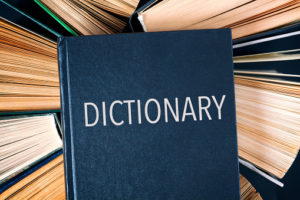An End Of Year Review of Dental Vocabulary and Definitions: Part 2
Remembering to schedule a checkup visit with your dentist is important. But it is also a good thing to know and understand some of the dental vocabulary you come across when at the dental office. Since it’s the end of the year, let’s take some time to review some common vocabulary terms and definitions used in a dental offices. This will help you become more familiar with different terms and understanding of different dental concepts. This is part 2 of the list of common dental terms and their definitions.
List of Common Dental Terms and Definitions
I
Impacted Tooth: An erupted or partially erupted tooth that is positioned against another tooth, bone, or soft tissue, so that complete eruption is unlikely.
Implant (dental): A device specifically designed to be inserted or placed surgically within or on the mandibular or maxillary bone as a means of providing for dental replacement.
Interproximal: A term used to describe between the teeth.
Intraoral: Inside the mouth.
J
Jaw: A common term for either the maxilla or the mandible.
L
Labial: Pertaining to or around the lip.
Lesion: An injury or wound or an area of diseased tissue.
Lingual: Pertaining to the tongue.
M
Malignant: Having the properties of dysplasia, invasion, and metastasis.
Malocclusion: Improper alignment of biting or chewing surfaces of upper and lower teeth.
Maxilla: The upper jaw.
Molar: The teeth posterior to the premolars (bicuspids) on either side of the jaw; the teeth used for grinding and chewing.
O
Occlusal: Pertaining to the biting surfaces of the premolar and molar teeth or contacting surfaces of opposing teeth or opposing occlusion rims.
Oral: Pertaining to the mouth.
Oral and Maxillofacial Surgeon: A dental specialist whose practice is limited to the interception and treatment of malocclusion of the teeth and their surrounding structures.
Overdenture: A removable prosthetic device that overlies and may be supported by retained tooth roots or implants.
P
Palate: The hard and soft tissues forming the roof of the mouth that separates the oral and nasal cavities.
Periodontal Disease: Inflammatory process of the gingival tissues and/or periodontal membrane of the teeth, resulting in an abnormally deep gingival sulcus, possibly producing periodontal pockets and loss of supporting alveolar bone.
Periodontitis: Inflammation and loss of the connective tissue of the supporting or surrounding structure of teeth with loss of attachment.
Plaque: A soft sticky substance that accumulates on teeth composed largely of bacteria and bacterial derivatives.
Pulp: Connective tissue containing blood vessels and nerve tissue which occupies the pulp cavity of a tooth.
R
Radiograph: An image produced by projecting radiation, or X-rays, on to photographic film that is commonly called an X-ray.
R
Root: The anatomic portion of the tooth that is covered by cementum and is located in the alveolus where it is attached by the periodontal apparatus or the radicular portion of tooth.
Root Canal: The portion of the pulp cavity inside the root of a tooth or the chamber within the root of the tooth that contains the pulp.
S
Scaling: Removal of plaque, calculus, and stain from teeth.
Sealants: Plastic resin placed on the biting surfaces of molars to prevent bacteria from attacking the enamel and causing caries.
Submandibular Glands: A major salivary gland located beneath the tongue.
T
Temporomandibularjoint (TMJ): The connecting hinge mechanism between the base of the skull (temporal bone) and the lower jaw bone (mandibular).
U
Unerupted: Tooth/teeth that have not penetrated into the oral cavity.
V
Veneer: The construction of crowns, a layer of tooth colored material usually made of composite porcelain, ceramic or acrylic resin and attached to the surface by direct fusion, cementation, or mechanical retention.
Give us at California Dental Group a call at (800) 407-0161 today if you would like to know more about any of the part 2 listed vocabulary and to schedule an appointment with us for a checkup.





